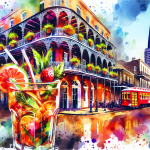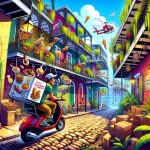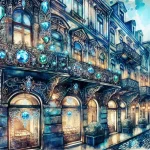New Orleans’ French Quarter, the historic center of the city, is renowned for its lively nightlife and revered cocktail culture. This iconic neighborhood has birthed numerous timeless cocktails that have captivated the palates of locals and visitors alike for generations. From the refined Sazerac to the refreshing Pimm’s Cup, the French Quarter’s cocktail scene is a testament to the city’s lasting love affair with mixology.
In This Article
TL;DR
- The French Quarter has played a pivotal role in shaping New Orleans’ distinct cocktail culture, with many iconic drinks originating from its historic bars and eateries.
- Classic cocktails like the Sazerac, Vieux Carré, and Ramos Gin Fizz are synonymous with the unique drinking experience found in the French Quarter.
- The ambiance and setting of French Quarter bars, with their rich history and architectural charm, enhance the enjoyment of these timeless libations.
The Historical Roots of French Quarter Cocktails
New Orleans has a storied history of cocktail innovation dating back to the early 19th century. The city’s strategic location as a major port and its diverse cultural influences contributed to the development of a thriving drinking culture. Early cocktail pioneers, such as Antoine Amédée Peychaud, the creator of Peychaud’s Bitters, and Philibert Guichet, the inventor of the Grasshopper, left an indelible mark on the city’s cocktail scene.
During the Prohibition era (1920-1933), when the sale and consumption of alcohol were banned in the United States, New Orleans’ proximity to the Caribbean and its lax enforcement of the law allowed the city’s cocktail culture to flourish. Speakeasies and private clubs became hubs for experimentation, leading to the creation of new and innovative drinks that would later become classics.
Iconic French Quarter Cocktails
Sazerac
One of the most renowned is the Sazerac, a potent combination of rye whiskey, absinthe (or Herbsaint), sugar, and Peychaud’s Bitters. Served in a chilled glass and garnished with a lemon twist, the Sazerac is a true embodiment of New Orleans’ spirit.
Vieux Carré
Another classic is the Vieux Carré, named after the French term for the “Old Square,” referring to the French Quarter itself. Created in the 1930s at the famous Carousel Bar in the Hotel Monteleone, this complex cocktail blends rye whiskey, cognac, sweet vermouth, Bénédictine, and both Angostura and Peychaud’s bitters. The result is a rich and flavorful drink that captures the essence of the neighborhood.
Ramos Gin Fizz
The Ramos Gin Fizz, a frothy and refreshing concoction, is yet another French Quarter mainstay. Invented by Henry C. Ramos in 1888, this labor-intensive cocktail combines gin, lemon and lime juices, orange flower water, egg white, sugar, and cream. The mixture is vigorously shaken for several minutes to achieve its signature velvety texture and is often served as a brunch or afternoon libation.
Notable Bars in the French Quarter
The French Quarter is home to a plethora of historic bars and restaurants that have played a significant role in shaping the city’s cocktail culture. One such establishment is the Sazerac Bar, located in the Roosevelt Hotel. As the name suggests, this elegant bar is renowned for its expertly crafted Sazeracs and offers a refined atmosphere for savoring the iconic drink.
Another must-visit spot is Pat O’Brien’s Bar, the birthplace of the Hurricane cocktail. Created in the 1940s, this rum-based drink, served in a distinctive hurricane lamp-shaped glass, has become a symbol of New Orleans’ fun-loving spirit.
For a taste of history, head to Lafitte’s Blacksmith Shop, one of the oldest surviving structures in the French Quarter. This candlelit bar, named after the infamous pirate Jean Lafitte, serves up the Voodoo Daiquiri, a potent frozen concoction that has become a local favorite.
The Art of Mixology in the French Quarter
The French Quarter’s cocktail scene is not only defined by its classic recipes but also by the skill and creativity of its bartenders. These mixologists are the guardians of tradition, preserving the time-honored techniques and ingredients that have made these drinks endure for generations.
At the same time, they are not afraid to innovate and put their own spin on the classics. Many bars in the French Quarter offer modern twists on traditional recipes, incorporating local ingredients and flavors to create unique and memorable drinking experiences.
The use of fresh, high-quality ingredients is a hallmark of French Quarter mixology. From hand-squeezed citrus juices to house-made syrups and infusions, bartenders take pride in crafting drinks that showcase the best of what the region has to offer.
The Role of Ambiance and Setting
The French Quarter’s iconic architecture, with its wrought-iron balconies, cobblestone streets, and historic buildings, provides a captivating backdrop for enjoying classic cocktails. The neighborhood’s bars and restaurants often feature design elements that pay homage to the city’s rich history and cultural heritage.
Many establishments boast lush courtyards, providing an oasis of calm amidst the bustling streets. Others feature live jazz music, adding to the sensory experience and creating an atmosphere that is quintessentially New Orleans.
The Carousel Bar at the Hotel Monteleone, for example, is famous for its revolving bar, designed to resemble a classic carousel. This whimsical setting, combined with the bar’s expertly crafted cocktails, creates a memorable and immersive drinking experience.
Seasonal and Festive Influences
The French Quarter’s cocktail scene is not immune to the influence of the city’s vibrant festivals and seasonal celebrations. During Mardi Gras, for instance, many bars and restaurants offer special cocktail menus featuring festive drinks adorned with the traditional colors of purple, green, and gold.
In the summer months, refreshing cocktails like the Pimm’s Cup and the Absinthe Frappé become more popular, offering a cool respite from the heat. The Pimm’s Cup, a favorite at the historic Napoleon House, combines Pimm’s No. 1 liqueur with lemonade, 7-Up, and a cucumber garnish, creating a light and invigorating drink.
Cocktail enthusiasts can also take advantage of the many cocktail tours and events offered throughout the year in the French Quarter. These guided experiences provide an opportunity to learn about the history and techniques behind the city’s most famous drinks while sampling them at some of the neighborhood’s most iconic bars.
Preserving Tradition While Innovating
As the French Quarter’s cocktail scene continues to evolve, bartenders and bar owners are faced with the challenge of balancing tradition with innovation. While many establishments remain committed to preserving the classic recipes and techniques that have defined the city’s drinking culture for centuries, others are embracing new trends and experimenting with modern twists on old favorites.
One example of this balance can be found at Arnaud’s French 75 Bar, where patrons can enjoy both traditional cocktails like the Sazerac and the venue’s namesake French 75, as well as more contemporary creations like the Bywater, a variation on the Brooklyn cocktail featuring aged rum, Green Chartreuse, Averna Amaro, and velvet falernum.
As the next generation of cocktail enthusiasts discovers the French Quarter’s rich mixology heritage, it is clear that the neighborhood’s bars and restaurants will continue to adapt and innovate while staying true to the spirit of the classics that have made them famous.
Expert Insights and Future Outlook
To gain a deeper understanding of the French Quarter’s evolving cocktail scene, we spoke with several local bartenders and bar owners. They shared their thoughts on the importance of preserving the neighborhood’s cocktail traditions while also embracing innovation and experimentation.
The French Quarter’s cocktail culture is all about balance,” says Chris Hannah, head bartender at Arnaud’s French 75 Bar. “We have a responsibility to honor the classic recipes that have defined our city for generations, but we also have an opportunity to put our own creative spin on things and introduce new flavors and techniques.”
Looking to the future, many experts predict that the French Quarter’s cocktail scene will continue to thrive, with a growing emphasis on sustainability, locally sourced ingredients, and experiential drinking. As more and more visitors discover the neighborhood’s rich mixology heritage, bars and restaurants will need to find new ways to stand out and attract the next generation of cocktail lovers.
“I think we’ll see a lot more collaboration and cross-pollination between bars and other local businesses,” predicts Tiffany Soles, owner of Justine. “Whether it’s partnering with local farmers and distillers or creating immersive, multi-sensory drinking experiences, the French Quarter’s cocktail scene will continue to evolve and innovate while staying true to its roots.”
As you explore the French Quarter’s vibrant cocktail scene, be sure to visit some of the neighborhood’s most iconic bars and restaurants, such as:
Sazerac Bar – Roosevelt Hotel, 130 Roosevelt Way, New Orleans, LA 70112; Open daily 11am-2am
Pat O’Brien’s Bar – 718 St. Peter Street, New Orleans, LA 70116; Open daily 10am-2am
Lafitte’s Blacksmith Shop – 941 Bourbon Street, New Orleans, LA 70116; Open daily 10am-3am
Carousel Bar – Hotel Monteleone, 214 Royal Street, New Orleans, LA 70130; Open daily 11am-1am
Arnaud’s French 75 Bar – 813 Bienville Street, New Orleans, LA 70112; Open daily 5:30pm-10pm
Whether you’re a cocktail connoisseur or simply looking to immerse yourself in the French Quarter’s rich drinking culture, these establishments offer a taste of the neighborhood’s enduring spirit and a glimpse into the future of New Orleans mixology.






